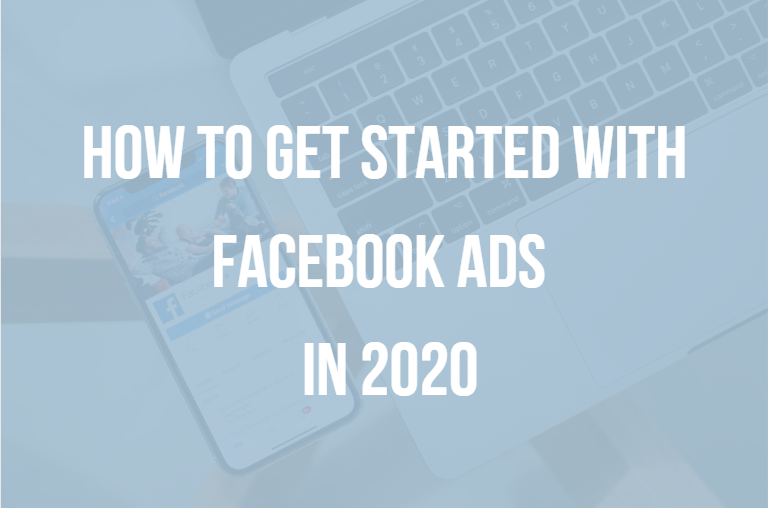This Facebook ads guide has written with the KISS technique. We Kept It Stupid Simple for total beginners but there is still a lot to take for advanced marketers too. Oh and it’s written in 2020, so this is as freshest as it gets.
Yes, the Facebook ads manager may look like a flight simulator to you at the moment.
It could seem confusing with hundreds of features, but we’ll show you the function of each future step by step. So in the end, you’ll know which buttons to press and eventually take off with your first Facebook ad campaign.
Here are the main things you’ll learn in this article:
- How to choose the right campaign objective. (awareness, consideration, conversion)
- How to pick your target audience.
- Understand the Facebook algorithm and take advantage of it.
- How to create a killer creative that brings you conversions
- Real-life cases and examples.
- Marketing tools to get you started today.
Of course, under these main pillars, you’ll learn many subtopics in detail. And all these combined will help you to build a solid foundation and give you the confidence to start with Facebook advertising.
Before we dive into how to advertise on Facebook, I want to show you why Facebook is still the go-to platform for advertisers.
Why Facebook Advertising?
Facebook is, by far, the most dominant social media platform. It’s inarguable.
And Facebook is more than Facebook. Here we’re talking about WhatsApp, Facebook Messenger, and Instagram.
It’s one mega platform that provides you access to different audiences from the same console: Facebook ads manager. So if you want to get discovered on social media in 2020, the combination of FB platforms is pretty much place to be.
We interviewed 2 smart Belgian companies to get their opinions and tips on Facebook advertising, you can swipe it to your reading list.
Ok, now let’s talk about you and specifically about your campaign structure.
A structure of a Facebook ad campaign.
There are three levels you need to consider. And it’s crucial that you understand the difference between the levels before you start to create your Facebook ad.

- Campaign: This is the highest level, where you are going to determine the goal of your campaign. What should the algorithm optimize for?
- Ad set: That’s where you pick your target audience and do all your targeting.
- Creative: The Facebook ads itself.
Not so long ago, experts used to have lots of campaigns and ad sets running at the same time.
Nowadays, FB guides you to reduce the number of campaigns and ad sets you have. Because this way, you can feed the algorithm with more data. And the more you feed the algorithm, the better it gets.
So we recommend having 4-5 campaigns running at the same time. And in those ad campaigns don’t get over 5 or 6 ad sets to start with. Allow algorithm to optimize your ads.
When you actually decide to create a Facebook ad? – Three types of Facebook campaign objectives.
Every dollar you spend on marketing has an intention behind it. To spend your money wisely and get the best return of investment out of it, you need to match your intention with Facebook’s three campaign objectives.
Let’s go over these three different options and see what fits your intention or goal best.
- Awareness.
- Consideration.
- Conversion.
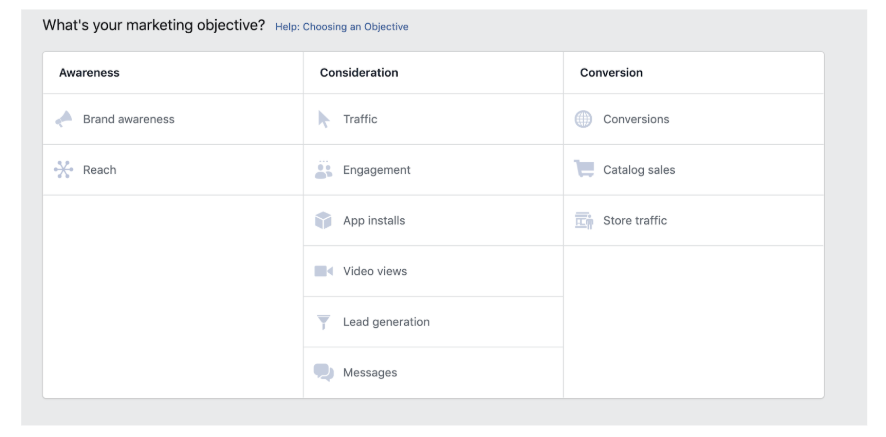
Awareness campaign
If you pick awareness or reach as your goal, you ask Facebook to show your ads to as many people as possible. But in that option, the algorithm won’t try to shows the people who will likely click or buy.
It’s similar to putting out your ads on TV.
Consideration campaign
Here you want people to take action and there are 6 subgoals under consideration objective.
1. Traffic ads: Most often, you want them to click on your website. And that’s when you’re going to use a traffic objective.
The best way to use it is by promoting content, particularly blog posts.
2. Engagement ads: Use it when you want to get interactions. For example, if you want to get likes on your Facebook page or want people to share your post and son.
If you have an organic post that already got good engagement and you may want to use that objective to show it more people.
3. App installs ads: if you want people to download your app.
The first 72 hours are critical for apps. You can use this objective to get as many as downloads possible to increase your rankings in the app stores.
4. Video views ads: Helps you to target people who likely view videos.
5. Lead generation ads: This is one of the newer objectives to make lead generation easy. Here you want people to submit their details right in the ad.
This especially makes it easy for mobile devices. When someone clicks your ad, Facebook opens the lead generation form and automatically fills the form based on the information people share with Facebook. Pretty clever right?
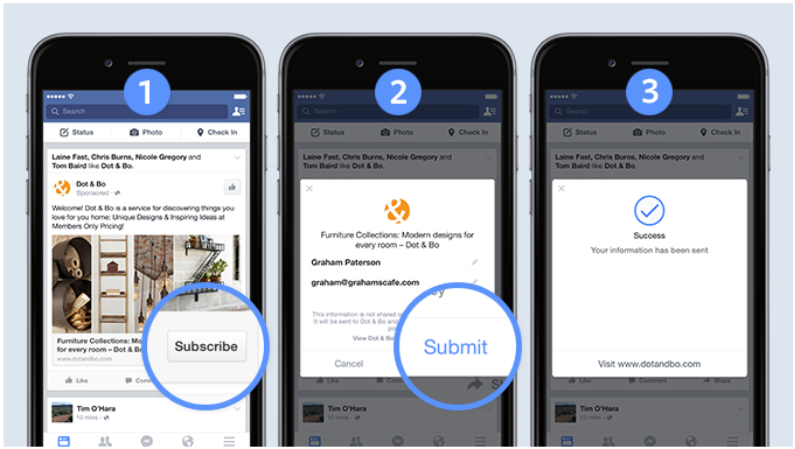
Here you see an example of a lead ad. Imagine you want to gather somebody’s email address for a white paper or your dentist and you want people to make an appointment with your cabinet.
This is how lead ads look like. So people actually interact with the advertisements and within the Facebook platform, they leave their details like their email address which then you can use to do your own marketing automation.
6.Messages ads: You want people to jump on a messenger conversation with you.
Those two last ones are very powerful because you create an interaction right away without the user having to leave the platform. Facebook loves it when users stay on the platform. So they’re always going to try to push those types of objectives.
And the other one is the send message ad.

It’s quite new but it’s powerful as well. Here the call to action is sent a message and then they’re directly sent to the messenger. And in messenger, you can start chatting with people in a conversational and personal way.
Conversion campaigns
Conversion is the holy grail of all goals. It’s the objective where you try to get people to buy something.
You have three ad campaign options under the conversion campaigns.
1. General eCommerce conversion.
Here the goal is to optimize for product views, add to cart, product purchases. It goes straight to the kill. If you’re trying to sell your product online, that’s your goal.
Here is a killer tip: Facebook needs to have a significant amount of data to allow its algorithm to optimize for maximum conversion rate.
So make sure your budgets are big enough that you generate enough conversions. So that Facebook can start optimizing who to show your Facebook advertising.
2. Catalog sales.
Imagine that you have a woman’s clothing e-commerce business and you have a huge product catalog.
With this objective, you can upload that catalog on Facebook. Based on your catalog and it’s own customer database Facebook will decide which products to show to which people.
This is especially powerful with people a bit more down the funnel.
Let’s say somebody came on your website, viewed a dress, and didn’t buy it. Facebook is going to show that dress to that person as many times as possible again. So there you don’t need to create the advertisements anymore.
Facebook is just going to take your product catalog then it’s going to show that to the relevant people.
Here you see an example of catalog sales.
(So imagine that you uploaded your whole assortment and then the next step is Facebook is going to show those products to the people most likely to buy and once you have a very big volume.)

Imagine you have a huge e-commerce store and Facebook knows very well who your target audience is based on previous purchases. The algorithm becomes very good at actually identifying those persons and showing them your product when they’re ready to buy.)
3. Store traffic.
If you have a couple of brick and mortar stores, you’ll love this one.
Here Facebook will optimize the delivery for people who are near your store. Then it can track the same audience based on the data of your cash register. This way you’ll know who saw your store ads and made a purchase from your store.
This is an example of store traffic at Macy’s clear example. They mention the products and then the call to action is “get directions”. You can’t buy those products on the website, but you’re actually shown where to go.
Imagine you’re just strolling down the city and see that Facebook ad campaign. When you take a break, you click on get directions, it opens your Google Maps and shows you the way how to get to the store.
And then Facebook is going to measure what the impact was on your store sales from your Facebook ads.

As you see, Facebook goes into more omnichannel and allows you to measure the result of your online campaign in an offline purchase in your store.
These are all the options you have for the campaign’s objectives.
You may think, “Ok but many of these objectives are matching with my goals”. Then we would recommend you to experiment with all of them, this way you could find what works best for you.
You have your objectives and we want to make sure you hit the targets with them. Onwards to the firing range.
Picking the right target audience for your Facebook ad campaign.
Who are you going to show your ads to? That’s a question and we believe that the formula of a high converting Facebook ad is = 50% targeting and 50% creative.
People spend a lot more time on creatives and amazing ideas. Should we change the copy? Should we shoot a video or make it a slick animation?
But targeting is actually half of the job and people often neglect the target. So we’ll make sure you understand the importance of targeting and teach you all the possibilities.
When you pick your audience, you have three different options:
- Saved audience
- Custom audience
- Look-alike audience.
Saved audience.
Okay, you just launched your website. You’ve never done a Facebook ad before and you don’t have a database of consumers. You’re just a newborn baby.
If this is the case, you’ll have to start with the saved audience.
This is an audience you try to target based on certain characteristics of your users.
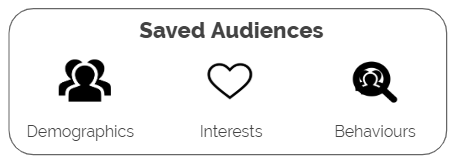
It can be demographic, for example:
If you have a women’s clothing brand, you can target the women between 25-60 years old in the neighborhood of Antwerp.
It can be interesting, for example:
For the same case, you can target people who are interested in Marie Claire or Vogue.
And the last one is behaviors:
You can target people who are about to get married, about to become parents for the first time, about to move countries. A scary one isn’t it? Heh.
Custom audience.
A custom audience is an audience you create based on your data sources.

Let’s say you have 10K email addresses (GDPR approved) that you’ve gathered. You can upload those email addresses and watch Facebook matching the email addresses with Facebook profiles.
This way, you can target people who interacted with your website, page, previous campaigns, liked your posts and etc. Plus you can also target people who did a specific offline activity.
For example: thousands of people came into your shop last weekend. In a month, you want to do a big promotion to target those people again. You can do it with the custom audience targeting.
So data = power. If you have that email addresses, upload it as early as possible.
It’ll be easier for you to sell, retarget or upsell to the audience who is already familiar with your brand. And that’s often going to generate the best results.
Lookalike audience.
This is where Facebook magic happens: it’s an audience where you’re going to feed the data to Facebook.

You have all that data from your website traffic, previous purchases, and customer files. Then you’re going to ask Facebook:
“Get me people that look like those people.”
However, you can’t say how they have to look. You have no idea who Facebook is going to target but here is our advice: Trust in Facebook’s algorithm.
Based on all the data it’s gathering, Facebook will look at similar buying profiles, demographic, location, interests and they’re going to show your ads to people who look like your audience.
This is the most powerful feature of Facebook targeting. And could be the non-stop engine that feeds your campaigns all the time.
It’s a bit more complicated than the others, so don’t start too early with this one.
We recommend that you need to have good enough data to feed Facebook to find the right people. If your data set is too small Facebook won’t be able to bring the right audience then you won’t have the results you want.
But for scaling up your successful campaigns, this is a super interesting option.
Behind the scenes of custom and lookalike audiences – Facebook Pixel
For all these data-feeding actions, you need something called a Facebook pixel. It’s a line of code that Facebook is generating specifically for you. And you need to put that on your website, that’s it.
I know the word “code” could also be read as “stressful” for some people. But it’s a simple copy-paste action so don’t get nervous. By doing so, you allow Facebook to track people from the moment they click on your ads.
Then Facebook knows who went on the website and viewed the product, downloaded an e-book, or purchased a product.
That’s the best way to use targeting. Because once your pixel is set, Facebook will match the people that come on your website with people that are having Facebook profiles.

Then you’ll be able to feed your look-alike audiences. Especially for scaling this is your power move.

Key takeaways:
Remember targeting is 50% of the job and you got three different options to target.
- Saved audiences when you’re just starting and don’t have a lot of data, you’re going to target interests.
- Custom audiences when you have an existing database.
- Then the miracle of Facebook lookalike audiences. Where Facebook is going to find clones, but remember look-alike audiences are only as good as the quality of the input feed it to Facebook. So you need to have a big enough data set to start.
How to create a killer Facebook ad creative
The other 50% of your Facebook advertising is your ad creative. This is the last element of the structure and what people see as the end result.
You have 5 types of Facebook ads creative:
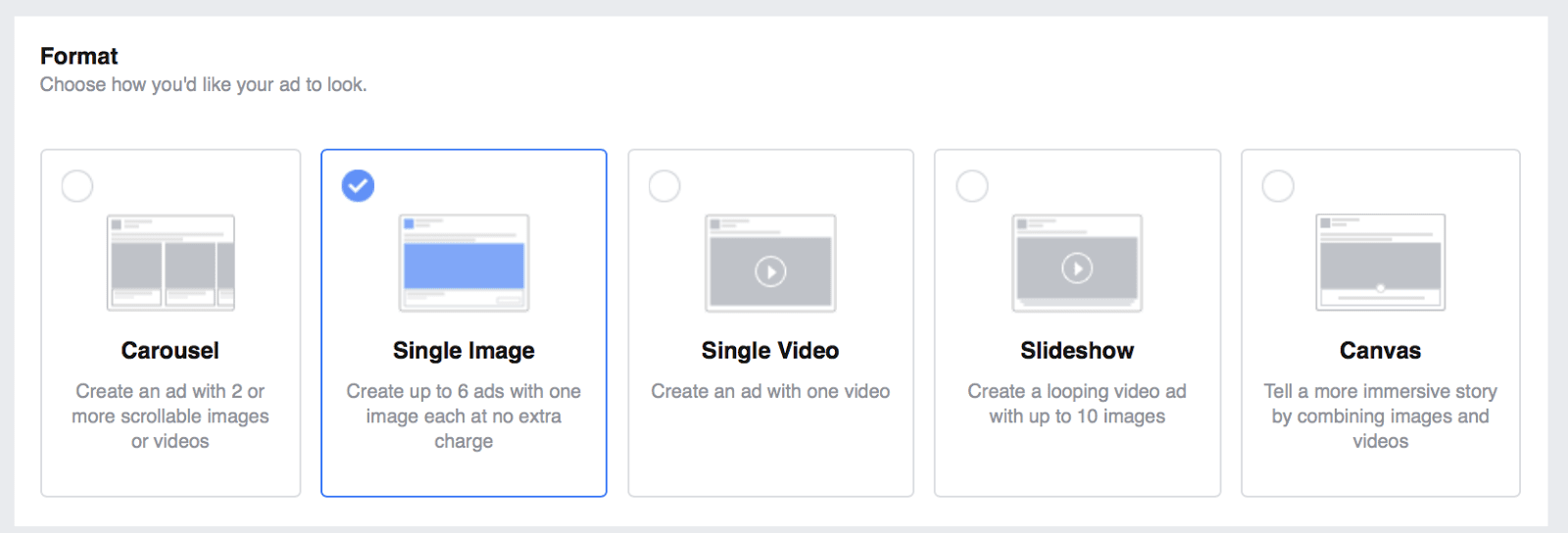
1. Single image
This is the most basic form of Facebook advertising but it’s still effective.
2. Carousel
A carousel is quite powerful because you’re paying the same money but can get x5 more ad real estate. With this extra space, you can explain more about your story or give more information about your product.
It’s also interactive and intuitive. Especially for mobile users, it’s a matter of swipe.
3. Single Video
Always keep in mind, Facebook is a mobile-first platform and it wants to keep people as long as possible on their platform. So Facebook favors and pushes videos more than any kind of content, because that what hooks people and keeps them on the platform.
Here is the translation of the first paragraph: “Video content is the king of Facebook ads”.
We know video is a scary format for the most. But you don’t need huge budgets, actors or actresses nor professional equipment. A long video with a static picture and some floating text is already considered as a video ad campaign.
So Facebook is allowing you to create a video just from a couple of pictures. And it’s enough to benefit from the Facebook algorithm.
Hold on, we’ll give our insider tips on video ads soon.
4.Slideshow
This ad type is not as popular as other Facebook ads. It’s a basic slideshow, however, if you’re good with storytelling and slides, you may give it a go.
5.Canvas (Only works in mobile)
This is immersive storytelling combined with video, text and static pictures. The canvas option is almost a mini-website experience in a Facebook post but it requires more craft and artistic perspective.
Here you can watch this video to appreciate the cool features of Canvas ads:
But it’s also not as common as the others. Because video or carousel is simply easier to create and more effective in terms of ROI.
Here is our advice on how to advertise on Facebook with all these creatives:
The golden rule: always have at least one video on your ad set. We recommend having one video, one image and one carousel in your ad set. Then back away for a while and let Facebook optimize which format it’s going to show to their users.
Also, we mentioned about the optimum number of ad sets before 3-5
Stick to these numbers and use the same Facebook ad creatives across each ad set.
You might change copy a bit depending on your targeting but use the same creative to see what works and what doesn’t work for different audiences. This way you can analyze your target audience and create better campaigns.
Here are some different types of Facebook ads in action:
On the left, you see just a regular image and on the right, you see a video.
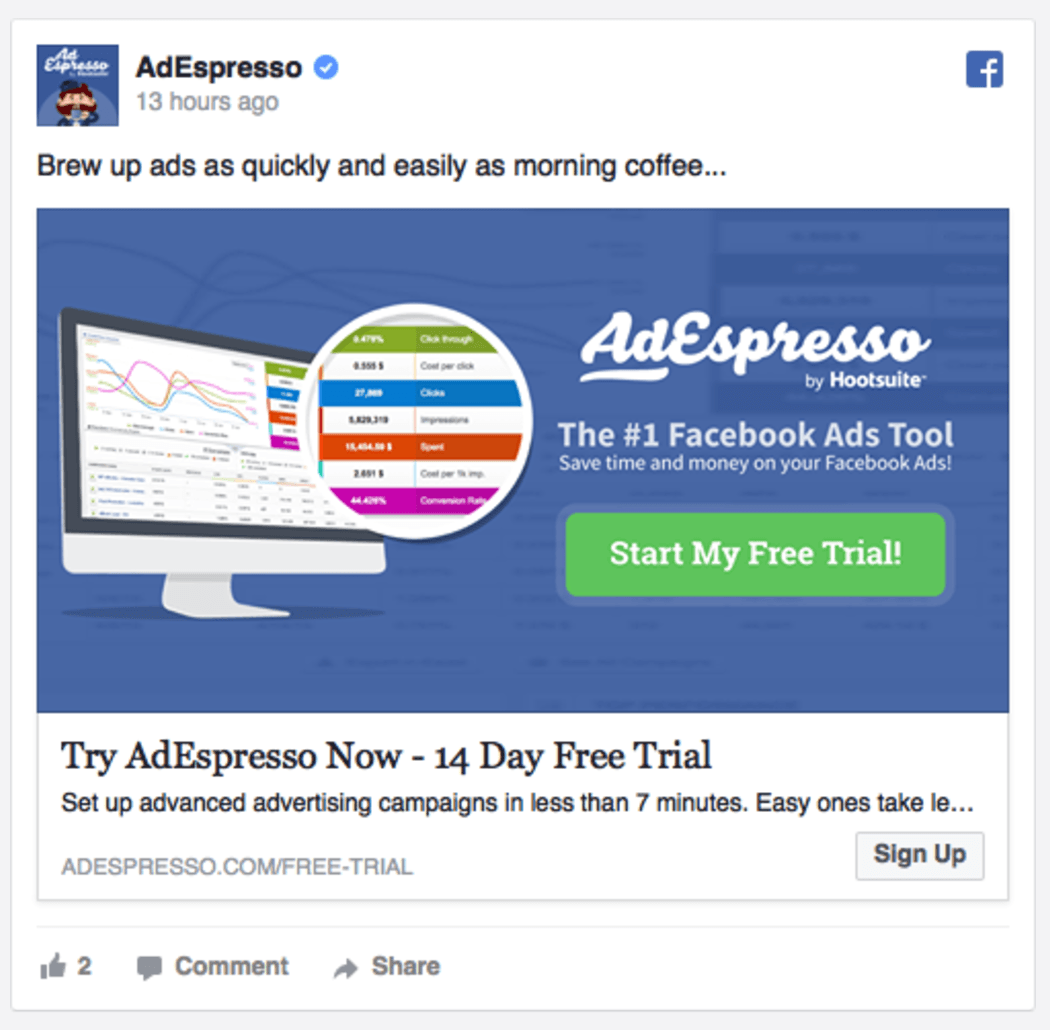

Again video is just moving things. It’s not necessarily people using your products and so on its just animation because that’s what Hooks users on the platform. And so Facebook will always try to push this type of creatives.

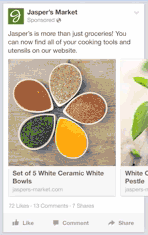
With a carousel, you can tell a whole story, especially on mobile. It’s powerful because it’s just a thumb scroll away. And that’s why we always recommend having a carousel as part of your ad creatives.
Now before we arm you with our best practices, we’ll show you the anatomy of Facebook advertising.
- Facebook page: You can’t advertise on Facebook unless you have a Facebook Page.
- Ad copy: A text to grab your audience’s attention and show your offer. It can be long or short. We’ll dive into details in a bit and show you what works best.
- Image or video: For us, this is by far the most important part of your Facebook ad creative. Because the image is the first area people focus on.
- Call to action: This is the bottom of your ad. Here you’ll write your description and call them to take action such as buy, download, click, or shop.
The behavior of the audience: Most people will first look at the image then headline and lastly to the ad copy. Keep that order in mind and always design your Facebook ads accordingly.
Remember Facebook is more than one platform. On Instagram, your headline is not showing, on Instagram its first the image and then directly into the ad copy. So make sure your ad copy is optimized for both platforms.
While we’re talking about ad copy, there is an important rule you should know.
20% text rule of Facebook Ads
You know the image is the first thing people look at Facebook ads. Then writing a copy on the image is a bright idea, right? You can grab attention and convey your message at the same time.
Yes, you can do that but up to a point. If your text covers more than 20% of your image, the algorithm will measure it and as a result, you’ll be penalized by Facebook.
Facebook will still run your campaigns and grab your sweet money. But you’ll get a warning sign in your ads saying “There is too much text”. And eventually, they’ll show it to fewer people than normal and this is not something you’ll want.
How can you understand if your ad image is ok? Well, you can take the official test from Facebook, here is the link to text overlay tool. Upload your picture and it’ll let you know if it’s no or go in seconds.
One sweet tip for video.
For your video ad campaigns, you need to pick a thumbnail(a preview image of your video). Use a thumbnail without any text to pass the 20% test. Then you can put text in your video with captions without having any problem with the algorithm.
Look, more tips coming on your way.
10 tips to create killer Facebook ads in 2020
There are tens of practices and psychological triggers to increase your conversions out there.
We created this list based on our learnings and observations. These are the practices that brought the best results for us so far. And we’ll show you the examples from one of our favorite brands: QIQO.
1. Make it colorful.
The attention is the only currency you have. Try to use brighter colors in your ads to grab the attention of your audience.
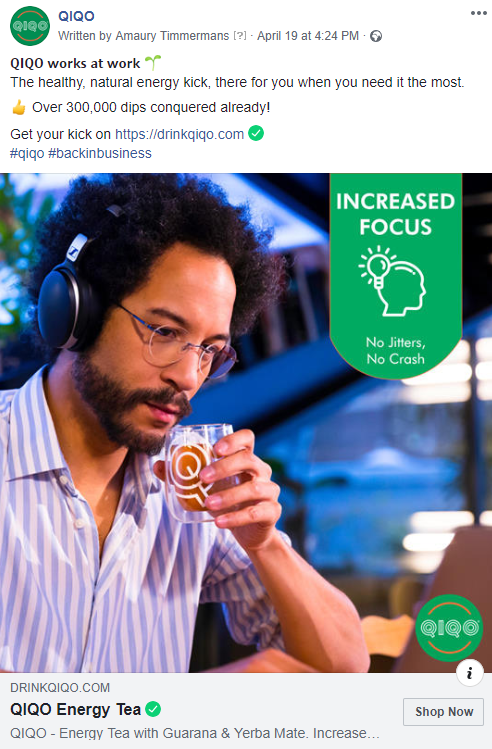
Here QIQO uses a bright green to stop people from scrolling down.
2. Place your value proposition in your ad.
Write the value proposition on your image. This way people will start to read it by the moment they saw your Facebook ads.
In this example, the message is clear “increased focus”. In the very first moment, viewers will know if they drink this product they’ll have increased focus and energy. And they’ll click on the ad if they’re interested in such a product.
3. Harmony of image, value proposition, and copy.
Your brain can connect the dots much faster than you think. Each element of this Facebook ad in harmony with each other and your brain understands it at the moment you see it.
4. Start the first sentence with an attention grabber.
You see “Qiqo works at work” is bold in the ad copy and there is an emoji. That might seem small, but these elements could stop the scrollers and invite them to spend more time in your ad. Seconds matter.
Also, Qiqo works at work is a short sentence and easy to read. After reading this snackable sentence, people more likely to get curious and read more.
Resources:
- You can use yaytext.com to change the font to italic or bold to capture the attention.
- Use Emojipedia.com comes handy when you’re using emojis in your copy. People are used to communicating and expressing themselves with emojis so use them to convey the feeling of your brand characteristic.
5. Add call to action in the headline
You already have the clickable call to action button at the bottom of your ads. But what if your readers don’t have the patience to go all the way to the bottom?
Unfortunately, this can be the case, and to increase the odds, you can add your call to action and URL to your main copy.
6. Use the Link Description to show authority, social proof and scarcity
“We sold more than 300.000 QIQO.”
This kind of psychological triggers can help you to show authority and social proof. People tend to trust other’s decisions and ideas when they don’t have one. So using this kind of trigger can help you break the judgmental barriers.
You can also create scarcity to incentivize people to take action. Here qollabi wrote “Only 43 posters remaining” which tells readers this is a limited offer. It’s another way of saying “it’s now or never”
By doing this, you can give the reader a sense of fear of missing out (FOMO) and make them click. Try to use these persuasion elements in your ad campaign to increase your conversions.
7. Use the magic word “Free”
You may think the word “Free” is cheap and losing its power. Indeed it’s cheap (well it’s actually free) but it’s powerful, people are less likely to resist when they see the word “Free”. It’ll increase your click-through rate (ctr) for sure.
8. Use actionable language in your description and call to action (Bottom)
Every ad has its own weak points. In this one QIQO’s description is missing an actionable verb such as try, drink etc.
So instead of QIQO Energy Tea, it could be better with “Drink QIQO now” description/CTA.
Note: You can also change the default CTA button as: learn more, shop now, go-to messenger, sign up; book now, and so on. In this case, it’s e-commerce, and “buy now “is the best CTA for impulsive products like QIQO.
9. Don’t make your headline too long
The Average headline length is five words and the average text length is 19 words. Shorter texts work for most of the brands, but remember this is a generalization.
It can be dangerous to compare your brand and strategy with averages. Because there are some cases out there which long copy beats the short copy.
So do test both and find out what works best for you.
Long copy often performs well when you have a story to tell. It could be your product story, a customer’s story, or any story that you want to tell.
10. Show real people that use your product.
Our brain is wired to look at other people’s faces and understand their emotions. That’s why this is an effective strategy for your Facebook ads.
It also counts as social proof because your customers will see other happy people that are holding or using your product. The same for the video, it can bring you much better results.
Pro tip: Using real people is especially effective for cold audience awareness campaigns.
You can download free high-quality images from these resources and can use it in your ads:
- Pexels.com
- Unsplash.com
- Thestocks.im
- Flaticon.com (for icons)
- Freepik.com
+1 Tips on Video ads
Most of us feel insecure and uncreative about video ads. Well, that’s because of the big production commercials we see on the television but hear this out:
People trust other people and they don’t care about the production of your video ads.
If you want to create a video ad campaign, film yourself with your smartphone camera and you’ll have better results than professional movie crew ads.
Because it’s much more authentic and creates a lot more trust. Other than that all the tips are applicable for the video ads.
What about Instagram ads?
Embrace the vertical story format on Instagram, it’s the biggest growing Facebook ad real estate Facebook is offering right now.
Keep in mind, you don’t have text or headline on Instagram stories ads. So always add a call to action to guide people to your end goal.
How to create a Facebook ad creative today and get started?
You don’t need photoshop, an expensive designer or freelancer to create your ads. You can make your own ads on Canva.com in 15 minutes, it’s free. There are hundreds of templates designed specifically for Facebook ads.
It’s even possible to create picture animations, gifs and you’re off to the races to get started.
The bottom line
You have the basics for sure and even you have some advanced strategies too. So, you have everything to start with your Facebook ads. As seasoned facebook ad experts we want to tell you one last thing:
This is a game of experimentation.
Every audience, brand, location, and many other factors are different. We hope all these strategies can work for you in your first time, but if not, don’t give up.
You’ll find your way, know your audience, create your best creatives and write the right copy along the way. This is a journey, enjoy it
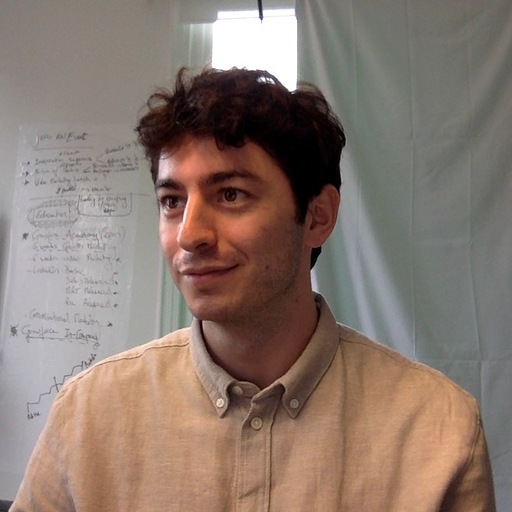
Yigit
Head of Content
I’m here to make sure you enjoy every bit of content you read.

